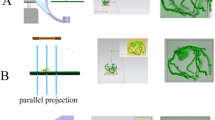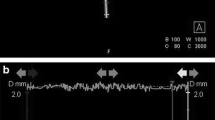Abstract
An algorithm for correction of the geometrical distortion in digital subtraction angiography (DSA) images was developed. Originally invented for 3D X-ray angiography, the algorithm was implemented in a computer program designed to fulfil the specific needs of stereotaxic DSA. The algorithm is based on transformation of an image of a grid from a distorted image back into its original pattern. The same transformation is then applied pixel-by-pixel to the angiographic images, which are acquired in direct conjunction with the grid image, without moving the gantry. The algorithm was tested in phantom studies and in the clinical situation with seven patients in ten examinations. Comparisons were made between co-ordinate determinations made on conventional full-size cut film and those performed on uncorrected and corrected DSA images, using 30- and 23-cm fields of view. With our method of measurement we could not show any remaining geometric distortion in the corrected DSA images. This distortion correction can, if properly applied, be used for high-precision stereotaxic DSA.
Similar content being viewed by others
Author information
Authors and Affiliations
Additional information
Received: 16 September 1995 Accepted: 5 January 1996
Rights and permissions
About this article
Cite this article
Söderman, M., Picard, C. & Ericson, K. An algorithm for correction of distortion in stereotaxic digital subtraction angiography. Neuroradiology 40, 277–282 (1998). https://doi.org/10.1007/s002340050585
Issue Date:
DOI: https://doi.org/10.1007/s002340050585




